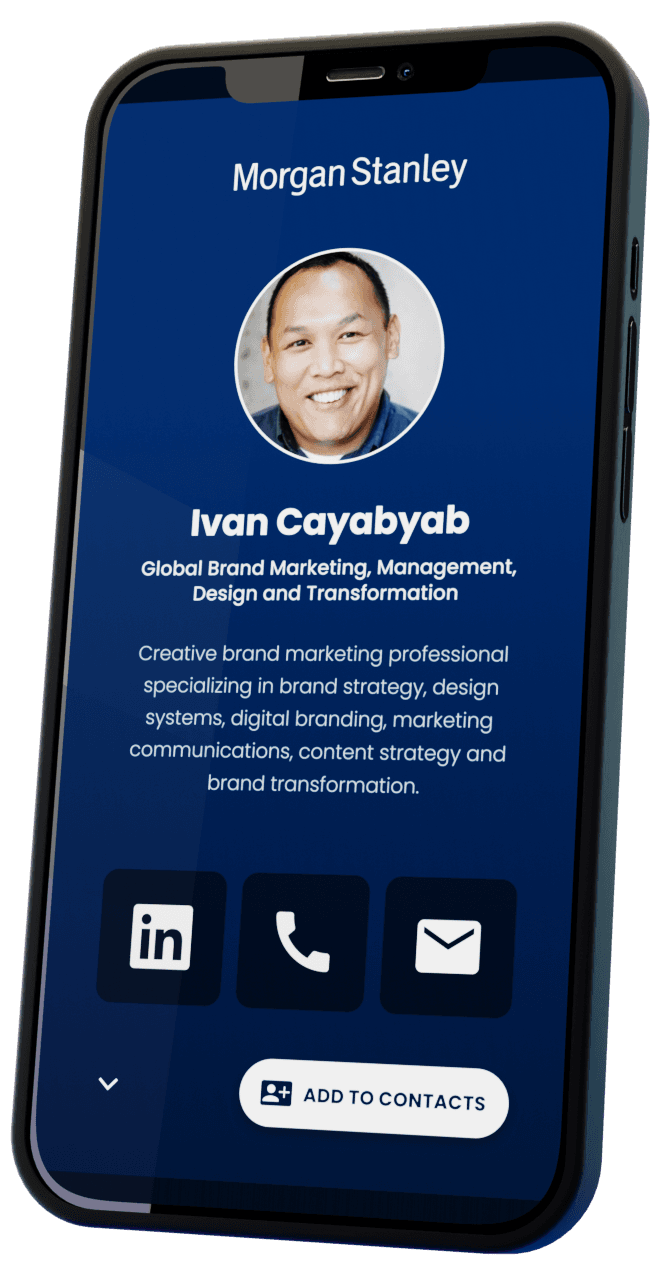In today's digital age, traditional business cards are no longer sufficient in capturing the attention of potential clients and customers. With the rise of smartphones and digital connectivity, it is essential for businesses to adapt their marketing strategies to leverage the power of digital tools. One such tool that has gained significant traction in recent years is the digital business card.
Digital business cards go beyond the basic contact information found on traditional cards. They provide an interactive and engaging experience for recipients, enabling businesses to showcase their brand, products, and services in a more dynamic and memorable way. By incorporating multimedia elements, such as videos, images, and links to social media profiles, digital business cards offer a unique opportunity to leave a lasting impression on prospects.
The benefits of using digital business cards for marketing
Digital business cards offer several advantages over their traditional counterparts. Firstly, they are easily shareable. With just a few taps on a smartphone, recipients can instantly forward a digital business card to their contacts, exponentially increasing its reach. This viral nature of digital business cards can significantly enhance brand exposure and lead generation.
Secondly, digital business cards provide valuable analytics and tracking capabilities. With traditional cards, it is challenging to measure their effectiveness and track the number of times they are viewed or shared. However, digital business cards can be integrated with analytics platforms, allowing businesses to gain insights into their performance. This data can be used to refine marketing strategies and optimize future campaigns.
Lastly, digital business cards offer a higher level of personalization. Unlike traditional cards that have limited space for information, digital business cards can accommodate a wealth of details, including product catalogs, testimonials, and client portfolios. This customization enables businesses to tailor their messaging to specific target audiences, increasing the likelihood of engagement and conversion.
How digital business cards work
Digital business cards operate on a simple principle: they utilize mobile applications or online platforms to create and distribute virtual cards. These platforms offer a wide range of templates and design options, allowing businesses to customize their digital cards to reflect their brand identity.
To create a digital business card, users can input their contact information, including name, job title, company name, phone number, email address, and website. Additionally, they can incorporate multimedia elements, such as logos, images, videos, and social media icons. Some platforms even offer advanced features like QR codes and geolocation tags, further enhancing the functionality of digital business cards.
Once the digital business card is created, it can be shared through various means, such as email, messaging apps, or social media platforms. Recipients can then save the card to their smartphone's contacts or bookmark it for future reference. This seamless sharing process eliminates the need for physical cards and ensures that the information is readily accessible to prospects.
Designing an effective digital business card
When designing a digital business card, it is crucial to prioritize simplicity and clarity. The card should have a clean and professional layout, with easily readable text and intuitive navigation. Extraneous information should be avoided, as it can overwhelm the recipient and dilute the key message.
The use of visuals is also essential in capturing attention and conveying the brand's personality. High-resolution images and videos can be utilized to showcase products, highlight achievements, or provide a glimpse into the company's culture. However, it is important to strike a balance between visuals and text to ensure that the card loads quickly and functions smoothly on all devices.
Furthermore, it is crucial to optimize the card for mobile viewing. With the majority of internet users accessing content through their smartphones, it is imperative that the digital business card is responsive and displays correctly on various screen sizes. This can be achieved by using a mobile-friendly design template and testing the card on different devices before distribution.
Integrating digital business cards into your marketing strategy
To fully leverage the potential of digital business cards, it is essential to integrate them into your overall marketing strategy. Here are a few key considerations:
Target audience: Identify the specific demographics and preferences of your target audience. This will help you tailor the design, messaging, and distribution channels of your digital business cards to resonate with your audience effectively.
Call to action: Include a clear call to action in your digital business card. Whether it's directing recipients to your website, inviting them to a webinar, or encouraging them to follow your social media profiles, a well-defined call to action can drive engagement and conversion.
Cross-promotion: Leverage your existing marketing channels to promote your digital business cards. This can include featuring them on your website, incorporating them into email signatures, or sharing them on social media platforms. By maximizing the visibility of your digital business cards, you can reach a wider audience and increase brand awareness.
Follow-up strategy: Develop a follow-up strategy to nurture leads generated through digital business cards. This can include personalized email campaigns, targeted social media ads, or even phone calls. By staying proactive and engaging with prospects, you can maximize the ROI of your digital business card marketing efforts.
Creative ways to use digital business cards for marketing
While digital business cards excel in providing contact information, they can also be utilized in innovative ways to enhance your marketing efforts. Here are some creative ideas to consider:
Product demonstrations: Incorporate videos or interactive elements into your digital business card to showcase your products or services. This can help prospects visualise the value you offer and create a memorable impression.
Digital portfolios: If you work in a creative industry, such as design or photography, a digital business card can serve as an interactive portfolio. Showcase your best work and provide links to additional samples or case studies to demonstrate your expertise.
Event promotions: Use digital business cards to promote upcoming events, such as webinars, workshops, or conferences. Include details like date, time, and registration links to encourage attendance and generate buzz.
Referral programs: Encourage recipients of your digital business card to refer their contacts to your business. Offer incentives, such as discounts or exclusive content, to incentivise referrals and expand your customer base.
Tracking and analysing the performance of digital business cards
One of the significant advantages of digital business cards is the ability to track and analyze their performance. By leveraging analytics tools, businesses can gain valuable insights into the effectiveness of their digital business card marketing campaigns. Here are some key metrics to monitor:
Views and shares: Track the number of times your digital business card has been viewed and shared. This metric indicates the level of interest and engagement generated by your card.
Click-through rate (CTR): Measure the percentage of recipients who clicked on the links or call to action buttons within your digital business card. A high CTR indicates that your card is successfully driving traffic to your desired destinations.
Conversion rate: Determine the number of leads or conversions generated through your digital business card. This could include sign-ups, purchases, or inquiries. By tracking the conversion rate, you can assess the overall effectiveness of your card in driving tangible results.
Bounce rate: Analyse the bounce rate, which refers to the percentage of recipients who leave your digital business card without engaging further. A high bounce rate may indicate a need for improvements in design or messaging to capture and retain the attention of recipients.
Examples of successful digital business card marketing campaigns
To inspire your own digital business card marketing campaigns, here are a few examples of businesses that have effectively utilized this tool:
XYZ Real Estate Agency: XYZ Real Estate Agency created a digital business card that featured a 3D virtual tour of their properties. Prospective buyers could navigate through different rooms and view detailed descriptions, floor plans, and contact information. This interactive experience significantly increased engagement and resulted in a higher number of site visits and inquiries.
ABC Fitness Studio: ABC Fitness Studio used digital business cards to offer a free trial class to new prospects. The card included a QR code that recipients could scan to redeem the offer. This campaign generated a high conversion rate, with many recipients eventually becoming paying members of the studio.
DEF Restaurant: DEF Restaurant incorporated customer testimonials into their digital business card. By including short videos of satisfied customers sharing their dining experiences, DEF Restaurant built trust and credibility, ultimately attracting more patrons to their establishment.
Choosing the right digital business card platform
When selecting a digital business card platform, there are several factors to consider:
Ease of use: Choose a platform with a user-friendly interface that allows you to create and customise your digital business card effortlessly. Look for drag-and-drop features and intuitive design templates.
Compatibility: Ensure that the platform is compatible with various devices and operating systems. This will enable your digital business cards to reach a wider audience and provide a seamless user experience.
Analytics and tracking: Look for platforms that offer robust analytics and tracking capabilities. The ability to measure the performance of your digital business cards is essential for optimizing your marketing efforts.
Integration: Consider whether the platform integrates with other marketing tools or platforms that you currently use. This can streamline your marketing processes and ensure a cohesive brand experience.
Conclusion: The future of digital business cards in marketing
As technology continues to advance, digital business cards are poised to become an integral part of every marketer's toolkit. Their ability to provide a personalised, interactive, and shareable experience makes them a valuable asset in generating leads, increasing brand exposure, and driving conversions. By leveraging the benefits of digital business cards and incorporating them into your marketing strategy, you can stay ahead of the competition and leave a lasting impression on your target audience.
Find out more - https://www.wingcard.io/blog/wing-digital-business-cards-uk



